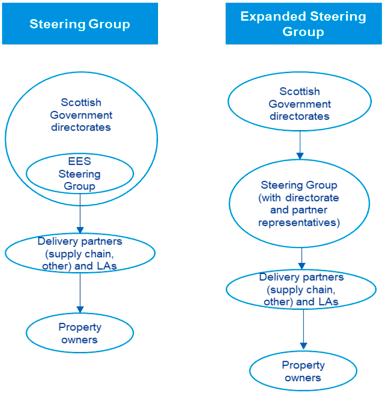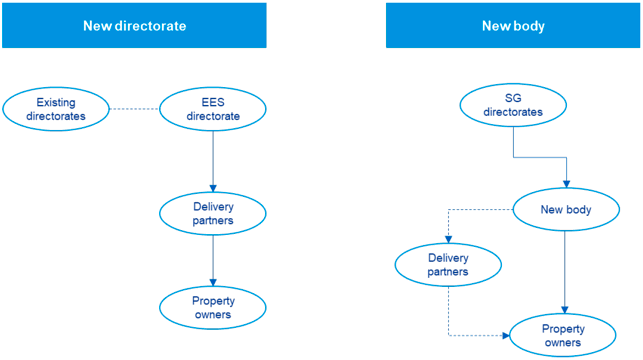Energy Efficient Scotland programme: analysis of delivery mechanism
Report exploring how best to oversee the delivery of our programme to improve energy efficiency and promote low carbon heating in Scotland's homes and buildings.
12 Outline management case
12.1 Key points
This chapter provides an initial outline of the management case for the shortlisted options. It focuses on the deliverability of the options, and key aspects of how the delivery body will be managed going forward, in particular the degree of freedom the body will have to deliver the aims of the EES programme.
- With delivery models that are further from Scottish Government, it will be important that they are set up in such a way that Scottish Government retains the required degree of control over strategic direction.
- In terms of deliverability, more arm’s length models will take longer to implement due to the need for legislation. However, given the length of the EES programme this does not preclude any options.
- The best performers are NDPB, Public Corporation and the new directorate. NDPB and Public Corporation score strongly across all areas of the commercial case. The new Directorate and Executive Agency also perform well, although these may be constrained in its ability to offer long term commitments, due to its dependence on the political cycle. Steering group models perform less strongly, due to a lack of a defined framework to allocate management responsibilities.
12.2 Management structure
The shortlisted options present several variations of management structure. These are summarised in the chart below:


In order to provide effective management of the EES programme, these structures must provide:
- Accountability on the roles and functions which have to be delivered;
- Effective interface with the supply chain and property owners and occupiers; and
- Adequate governmental or parliamentary oversight, and the ability to intervene and change priorities.
None of the models above prevent the conditions being fulfilled. However, for some models where the delivery is close to Scottish Government (Steering Group models) arrangements will be more informal, with the involvement of multiple directorates and delivery partners, which creates scope for a less clear governance model.
For arm’s length models, it will be important to ensure that the Scottish Government retains the control it needs to make changes to programme delivery (while recognising the benefits of giving the management of the body the freedom to deliver EES as they see fit).
Relevant staff should attend the Scottish Government’s internal joint network group which covers all bodies being established, as this a good forum for information gathering on previous learnings.
12.3 Project deliverability
Models that are closer to Scottish Government (Steering Groups, creation of a new directorate) will be easier to set up than more arm’s length bodies. However, care would still need to be taken to create a model that allocated responsibilities between the various stakeholders (different directorates and partners such as Local Authorities).
If a decision was taken to create a new public body, Scottish Government guidelines recommend that it should have at least 3 operational years. Given that the EES programme will run until 2040, a new delivery body would meet this condition.
For options that involve the creation of a new public body through legislation e.g. Public Corporation, Executive NDPB, there is likely to be a significant time lag (of up to 3 years) before the new body is fully operational. Given that:
- Clarity around many of the roles a new delivery body would provide are subject to further policy decisions; and
- Transitional governance arrangements could be put in place while the administrative/legislative process for setting up a new body was followed.[54]
12.4 Areas for further consideration
Given that the management case is currently at an early stage, more work will be required to develop it more fully in future iterations of the business case, in particular:
- Identification of clear delivery dates and milestones for the creation of the delivery body, including legislative timetable;
- Proposed programme management approach for creation of delivery body;
- Plans for post implementation evaluation arrangements; and
- Contingency planning, and approach to management.
Table 18: A summary of management case assessment
| No |
Option name |
Degree of government control |
Ability to build and preserve organisational knowledge |
Ability establish enduring commitments, independent of political cycle |
Responsiveness to changing circumstances |
Delegated management freedom in delivering purpose |
Ease of transition to new model |
Clarity of governance model |
|---|---|---|---|---|---|---|---|---|
| 1 |
Steering Group & Scottish Government delivery |
Higher
|
Lower
|
Lower
|
Higher
|
Lower
|
Higher
|
Lower
|
| 2 |
Scottish Government Local Collaborative Structure |
Medium
|
Lower
|
Lower
|
Higher
|
Lower
|
Medium
|
Lower
|
| 3 |
Creation of EES Directorate |
Higher
|
Medium
|
Lower
|
Higher
|
Medium
|
Higher
|
Higher
|
| 4 |
Executive Agency |
Higher
|
Medium
|
Lower
|
Higher
|
Medium
|
Medium
|
Higher
|
| 5 |
Non-Ministerial Office |
Medium
|
Medium
|
Medium
|
Lower
|
Medium
|
Lower
|
Higher
|
| 6 |
Executive NDPB |
Medium
|
Higher
|
Medium
|
Medium
|
Medium
|
Lower
|
Higher
|
| 7 |
Public Corporation |
Medium
|
Higher
|
Medium
|
Medium
|
Medium
|
Lower
|
Higher
|
Contact
Email: james.hemphill@gov.scot
There is a problem
Thanks for your feedback